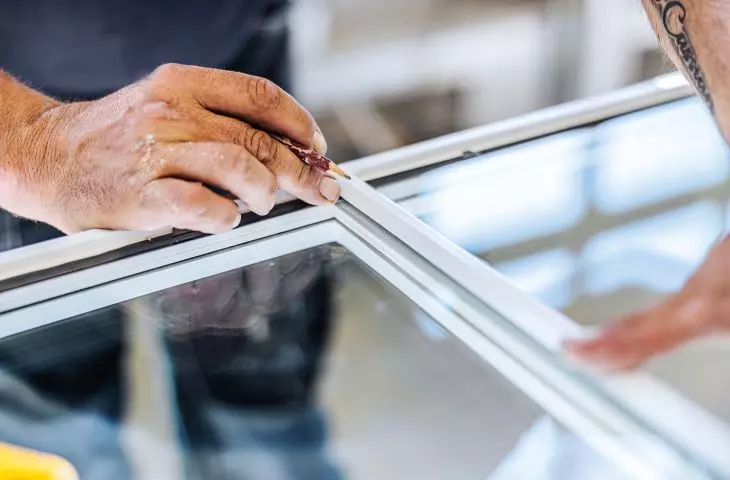During the reconstruction of a building in Basel, it was possible to preserve the original exterior appearance of the historic windows and achieve excellent energy efficiency. The use of heat-insulating glass with particularly high light transmission, as well as extra-narrow insulating glass and a warm spacer in the edge insulation area, made it possible to achieve adequate interior illumination in the historic building and exceptional thermal comfort.
Brothers Georg and Rudolf Stamm apparently attached importance to energy efficiency as early as 1897, even if they wouldn't have described it as such themselves. In the Basel townhouse they built at the time, single-glazed windows, typical of the period, were still installed in the household and domestic rooms, but double glazing was chosen for the formal living rooms, which provided much better protection from the cold. In front of the interior fixed window, the Stamm brothers installed a removable secondary window at the façade level, resulting in an energy effect similar to a box window.
During the reconstruction of the Basel townhouse, the original exterior of the historic windows was preserved.
© SWISSPACER
The listed building, located in a conservation zone, has been completely renovated over the past two years. Schröer Sell Architekten of Basel was responsible for managing the design and construction.
The project consisted of modernization that did not interfere with the building's structure, while preserving or restoring as many period elements as possible, explains lead architect Carmen Eichenberger. - This included energy upgrades to the roof and restoring the layout of the dormer windows to look typical of the period in which the townhouse was built. However, the layout of the rooms and typical structural solutions, such as the interior skylight, windows, and glazed front and rear doors, were retained.
Thanks to a special low-emission coating, Saint-Gobain Glass' ECLAZ LIGHT insulating glass combines the high energy efficiency typical of double-glazing with the effective interior lighting provided by single-glazing.
© SWISSPACER
Extra slim double glazing unit
Together with Holzmanufaktur Rottweil, which undertook the window renovation, the architects developed a solution that preserved the original appearance of the facade, with exterior glazing made of drawn glass.
We refurbished the frames of the fixed windows and re-glazed them with the original glass," is how project manager of Holzmanufaktur Rottweil, Dirk Obser, describes the procedure. - So from the outside, the historic glass with its imperfections and undulations can once again be admired.
The inner sash frames were also refurbished and reused, but in this case the modern CLIMAPLUS ECLAZ LIGHT XN insulating glass from Saint-Gobain Glass was used. Thanks to a special low-emission coating, it achieves the energy efficiency typical of triple glazing, while allowing as much daylight into the interior as double glazing. The single-chamber insulating glass unit is only 16 mm thick. The result is an exceptionally flat interior glazing with a 3-10-3 configuration and a visually elegant solution in old frames.
The use of heat-insulating glass with high light transmission and a warm spacer in the edge insulation area made it possible to achieve adequate interior lighting of the historic building and thermal comfort.
© SWISSPACER
With a light transmittance of up to 83%, ECLAZ LIGHT glass allows optimum illumination of rooms with natural daylight, so even in historic buildings with relatively small windows, modern, bright interiors can be easily created. The high color neutrality of ECLAZ LIGHT glass also ensures good color and contrast reproduction, and the extremely low iron oxide content of the base glass avoids its typical green tint.
Energy efficiency thanks to a warm spacer
Excellent edge sealing performance also contributes to the high energy efficiency of the narrow glazing unit. SWISSPACER spacers provide excellent insulation thanks to their low thermal conductivity and low psi values. The temperature at the edge of the glass remains high, eliminating the risk of condensation and mold growth. Dirk Obser sees another, probably equally important reason why Holzmanufaktur Rottweil regularly uses SWISSPACER spacers: - With them, the edge of the glass simply looks its best!
Thanks to the narrow but highly energy-efficient design of the insulating glass unit using ECLAZ LIGHT glass and the SWISSPACER Advance spacer, the historic interior window frames could be reused without any visible modifications. The component thus retained a virtually unchanged exterior appearance, but thermal insulation that complies with today's standards was integrated into it.
The use of ECLAZ LIGHT glass and the SWISSPACER Advance spacer makes it possible to achieve an insulating glass unit with particularly high energy efficiency. As a result, it was possible to reuse historic interior window frames without any visible modifications.
© SWISSPACER
The same idea was followed in the modernization of the two glass doors leading to the street and to the terrace on the courtyard side. Here, however, the possibilities for using insulating glass were even more limited. As a result, a completely new vacuum glass was required for the street-side entrance doors. For the terrace door, Holzmanufaktur Rottweil, on the other hand, relied on its own solution called REVETRO. It consists of placing the historic glass in the outer position in a new insulating glass unit construction. As a result, when looking at the Stamm brothers' building from the courtyard, the unevenness, waviness and bubbles of the original drawn glass are clearly visible. This element gives the facade a charming historical character.
For more information, visit the company's SWISSPACER page on the AiB portal.




























